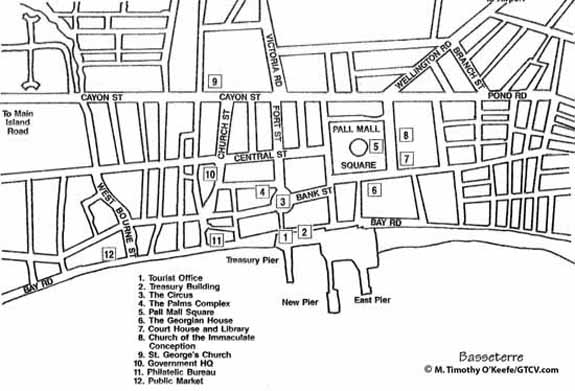Basseterre,
St. Kitts Walking Tour |
Easy with our Basseterre street map |
||||
|
Basseterre Walking TourAn hour's easy walk will show you all of the highlights of Basseterre, the historic capital of St. Kitts with about 15,000 inhabitants. Basseterre is ideal for exploring on foot since everything is laid out in square blocks. Basseterre has been the British capital of St. Kitts since 1727, though it was part of the French sector when the two nations both held the island. The name Basseterre in French means ?low land,? which most of the commercial district certainly is; it has been flooded several times. Bassterre's walking tour begins right at the cruise dock.
1. The Pier Area: Three different piers, including separate ones for cruise ships and the "Caribe Queen," the island ferry that runs between St. Kitts and Charlestown, capital of Nevis. Friday and Saturday are particularly good times to be at the pier, when the colorful produce and vegetable market is in session. Ask first before taking photos of individuals and don't be surprised if they say "No" or want you to buy something first in trade. 2. Old Treasury Building: One of the most architecturally interesting structures near the pier is the old Treasury Building with its big rotunda. Also the customs house, this domed colonial building and its arches are a good reminder of just how rich sugar once made the island. 3. The Circus: In British lingo, a circus is not a good time under a big canvas tent but refers to a circular open space at the intersection of several streets, as London 's Piccadilly Circus. The small roundabout is lined with good shopping, particularly at The Palms Arcade. Dominating The Circus is the large green cast iron Berkeley Memorial Clock. The ornate grandfather-style clock with four clock faces is a memorial to Thomas Berkeley, a former president of the Legislative Assembly. 4. Independence Square: Originally known as Pall Mall Square, it was built in 1790 for slave auctions and council meetings. It was renamed in 1983 to commemorate the independence of the island Federation of St. Kitts and Nevis from Great Britain . Nothing remains of its bleak origins. Instead, a large fountain decorates the center and the perimeters are bordered by old stone buildings and neat, aged, wooden structures painted in white and colorful pastels, all excellent examples of British Colonial architecture. 5. The Georgian House: Bordering Independence Square, this restored brick home is now a gourmet restaurant. 6. Court House and Library: Directly opposite Independence ( Pall Mall ) square and adjacent to the Catholic church. 7. Church of the Immaculate Conception: This open, airy church is a reminder that during the French period, Catholicism was the predominant religion. 8. St. George's Anglican Church: A large brownstone church located on an interesting and fiery religious battle site. It's been destroyed so many times it's difficult to tell whose side God ended up on, the French or the British. Originally, the French built the church "Notre Dame" here in 1670, which the British burned down in 1706. The British rebuilt 4 year's later, naming their new Anglican structure after the patron saint of England. However, a fire in 1763, an earthquake in 1843, a hurricane, then another
fire in 1867 resulted in St. George's being destroyed and rebuilt three more
times. What you see standing for the moment is the result of the last restoration,
in 1869.
|
|||||

